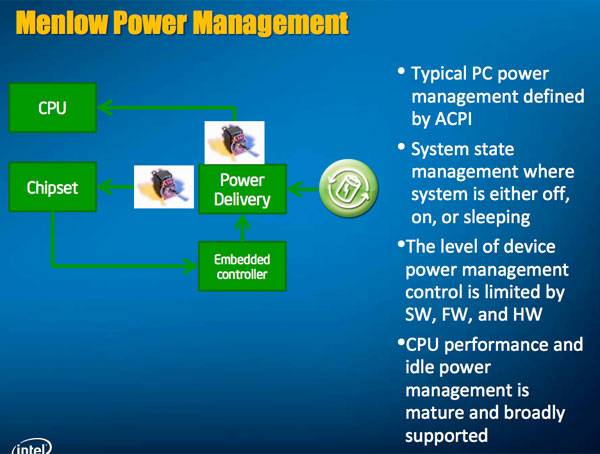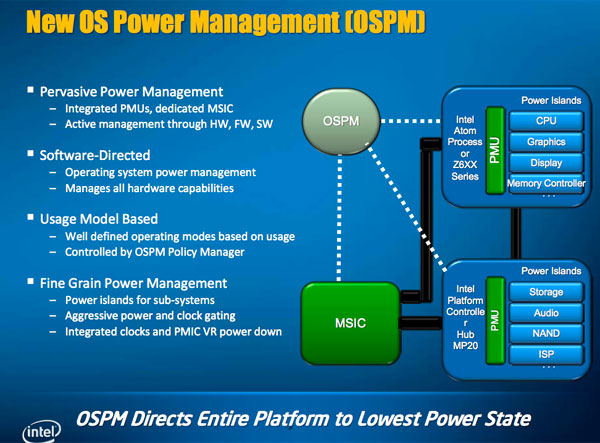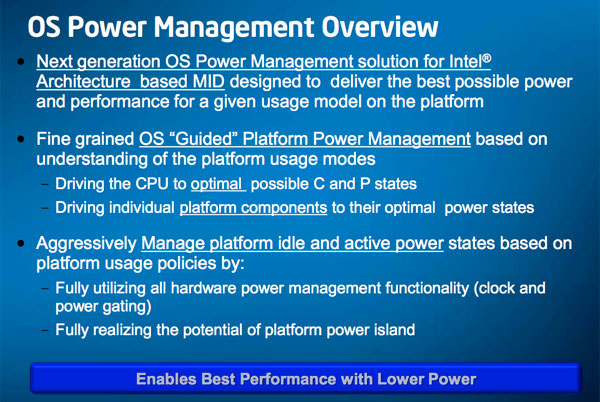Intel Unveils Moorestown and the Atom Z600, The Fastest Smartphone Platform?
by Anand Lal Shimpi on May 4, 2010 11:54 PM EST- Posted in
- Smartphones
- Intel
- Atom
- Mobile
- SoCs
OS Driven Power Management
When Intel introduced Nehalem and the Core i7, we saw a new generation of power engineering in microprocessors. In the past, the OS would request a particular performance state from the CPU and the chip would respond by changing its clock speed. Nehalem’s Power Control Unit (PCU) instead dedicated enough transistors to build a 486 to monitoring the power and performance demands on the chip. Based on those demands and what the OS was doing, the PCU would power up or down individual cores, as well as move clock speeds up or down. The PCU would guess at what the OS was trying to do and respond accordingly.
Nehalem and its successors were massive chips, eating up to 130W of power under load and idling down in the 6 - 10W range. Lincroft has to be sub-1W under load and 6mW at idle. With even more stringent power demands and a much smaller die, Intel couldn’t blow a sizeable percentage of the Lincroft transistor budget on power management.

Instead of guessing at what the OS wants, the Moorestown platform uses OS Driven Power Management (OSPM) to tell Lincroft and Langwell what to do. OSPM is supported in Moblin and presumably the Wind River build of Android.

The OSPM process tells the hardware what apps it’s running and to shut down what it doesn’t need. There are well defined operating modes - standby, internet browsing, MP3 playback, video playback, voice call, video capture, etc... Based on the profile, the hardware doesn’t have to guess at what it should turn off/on, it just does it right away.
The OSPM driver communicates directly with the two power management units in Moorestown - one in Lincroft and one in Langwell. It instructs those PMUs to shut off various blocks, and in turn they tell Briertown to gate and cut voltage to the parts of chip that aren’t needed.

I wondered if this couldn’t be done in hardware, but it seems that given current die constraints and the sort of accuracy of information it needs Intel must implement at least some of the power management control in software. Toolkits will be available for developers to control the OSPM.










67 Comments
View All Comments
Mike1111 - Wednesday, May 5, 2010 - link
IMHO Anand meant app-centric smartphones, David Pogue calls them app phones.jasperjones - Wednesday, May 5, 2010 - link
i don't see how recent symbian devices are not "app centric." you have the publicly available sdk, the ovi store, etc.BrooksT - Wednesday, May 5, 2010 - link
So your argument is that symbian is a bigger player in the app phone market than Apple because their *latest* phones support apps?The "smartphone" / "app phone" semantic difference is annoying, but if we look at, say, number of applications available or downloaded, Symbian and RIM are distant third and fourth places. Likewise with app usage, even just internet browsing.
If you want to talk about smartphones as they existed in 2006, then yes, both Symbian and RIM are much bigger than Apple or Android.
jasperjones - Wednesday, May 5, 2010 - link
To clarify: I said "recent" because the first Symbian smartphones came out almost 10 years ago--of course, those weren't app-centric.My original comment on Anand's article still stands. I'm talking about IDC's and Canalys' reports on 2010:Q1 smartphone sales which became available just days ago. Of course, most of the smartphones sold by Nokia and RIM in the first quarter allow for installation of apps such as Facebook, Ovi Maps, etc., etc.
WaltFrench - Sunday, May 9, 2010 - link
“…Apple and Google dominate the smartphone market. This is utter nonsense.”All you have to do is to look at the developer space. How many app developers are creating apps for the unreleased RIM OS 6? … for the Symbian OS^3, due out in “select” markets sometime in Q3?
If older apps work OK in these new OS incarnations, and if Blackberry and Nokia users are heavy app downloaders (or for some reason will become heavy users), then the current sales-share leaders are relevant, but still not dominant, in the future of app phones.
nafhan - Wednesday, May 5, 2010 - link
I'm curious about the PCI bus requirement for Windows 7 that would prevent it from running on Moorestown devices. Does it have something to do with storage, maybe? I'm having trouble finding specifics online as well. If someone could enlighten me, it would be appreciated.DanNeely - Wednesday, May 5, 2010 - link
This is almost certainly a factor of windows being a monolithic kernel and MS not having any way to say "this PC doesn't do PCI". This is something that MS will have to deal with in the medium term future anyway. PCI slots are going away from some high end mobos; it's only a matter of time before they disappear from mainstream boards and stop being used to attach misc controllers like PATA (slowly going away entirely) or FireWire (FW3200 will need PCIe bandwidth). At that point intel will want to take it out of their chipsets as a cost saving feature, and oems will not be happy if they have to install a PCIe to PCI bridge to maintain windows compatibility.Drizzt321 - Wednesday, May 5, 2010 - link
Maybe HP/Palm should get with Intel and optimize WebOS for this. Much of the WebOS stack is just Linux, Webkit, plus other F/OSS stuff like gstreamer and the like so I wouldn't be surprised if it isn't as big an effort as, say, Symbian or anything like that.This could be a big break for Intel and HP/Palm, since HP/Palm needs something big to help it move on to the next WebOS device, and the OS could certainly see some benefits to more CPU power. I've heard the overclocking patches raising the CPU to 800MHz can really help things.
sleepeeg3 - Wednesday, May 5, 2010 - link
Please stop designing faster phones.Phone A lasts 24 hours standby
Phone B lasts 6 hours standby
After 6 hours, Phone B's battery is dead. How much use do you get out of a phone with a dead battery? 0.
999GHz x 0 is still... 0!
This push toward faster phones, without even considering battery life, is nuts. Phones are impractical tools for just about everything, but calling, messaging and photographs. None of these are CPU intensive. Dependability is more important than how fast the dial screen opens.
Moorestown may include better power architecture, but it throws this away by jacking up the processor speed.
Lets get back to practicality and make phones functional again. This push toward cutesy 1000mAH/1GHz+ phones that die in a few hours is moronic.
Is it too much to ask for phones that last a week?
metafor - Thursday, May 6, 2010 - link
There are plenty of phones that last a week...They even cost significantly less than GHz smartphones and usually don't come with a 2-year contract.
But they don't have giant 4.2" AMOLED screens (which btw, is ~50% of the power consumption) either.